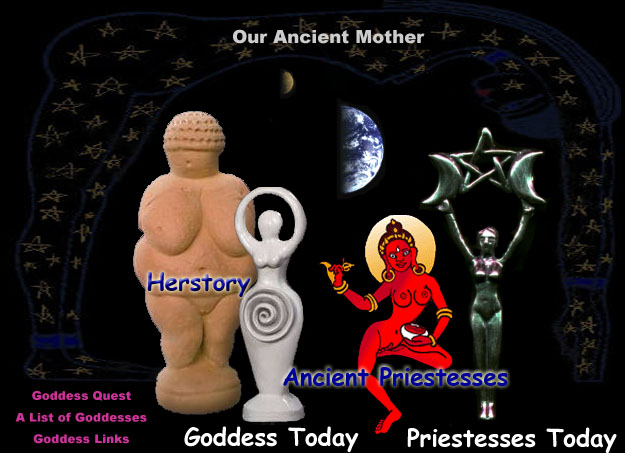Priestesses
From suppressed histories.com
Holy women are more visible historically than most women, and more likely to be accorded honor and power in their own right. Their authority tends to transcend division of society into religious and political spheres. Priestesses often lead liberation movements: Veleda of the Bructerii in the lower Rhine, Dahia Kahina in Tunisia, Maria Candelaria in Chiapas, Toypurina in southern California, or Nehanda Nyakasikana in Zimbabwe.
Many indigenous cultures uphold female spiritual leadership --for example, the Mapuche of Chile, the Karok and Yurok of California, as well as numerous cultures in South Africa, Siberia, and Indonesia-- while imperial and feudal societies generally suppress women's open exercise of religious authority. So the temple women disappear from west Asia, patrician Rome tries to stamp out the Women's Mysteries, witches are burned across Europe, and mandarins persecute the Wu. Still, female resistance bubbles under the surface of "major" religions, in forms officially dismissed as "cults." Sacramental dance and other ways of entering altered states of consciousness often play an important role in these rites that bypass socially decreed hierarchies, as do animistic consciousness and nature sanctuaries.
Barring women from ritual leadership and religious authority has been a key way to undermine female power in many societies. Its relationship to the institution of legal codes subordinating women is undeniable, often stated explicitly in scriptures of the "major" religions. Over centuries, the edition and selection of canonical works has operated to erase traditions of female leadership, such as the Gnostic scriptures naming Mary Magdalene as the foremost Christian disciple, or female images of the Divine, as in the hadith known as "the Satanic verses."
Numerous indigenous legends also describe a male takeover of rites and mysteries originally celebrated by women, as in Australia, Tierra del Fuego, and Sierra Leone. The pushback of priestesses' authority is also historically attested in the pagan Mediterranean, where priests took control of oracular shrines such as Delphi, the Mysteries at Eleusis (where the Melissae legally contested encroachments on their traditional rights) and the holy of holies of Ephesus in Anatolia, where women were forbidden entry by Roman times.
Conversely, priestesses in patriarchal cultures often enjoyed rights and liberties denied to most women, not least their own property, income, and child custody, as well as the prestige of public office. While celibacy was often a requirement, sometimes the priestesses escaped the sexual constraints on ordinary women.
The devadasi of India chose partners and their children followed the matrilineal line. Babylonian titles of priestesses include such names as: zer mashitum, "woman who forgets the sperm," and zinishtum zikrum, "male woman," both of whom had a degree of independence derived from paternal inheritance in their own right.
One Babylonian writer warned men, "Do not marry a prostitute, whose husbands are legion, An ishtaritu woman who is dedicated to a god, A kulmashitu woman whose... is much. When you have trouble, she will not support you, When you have a dispute she will be a mocker. There is no reverence or submissiveness within her..."
In countless cases, cultures that welcomed female spiritual leadership have been stigmatized as barbaric and inferior by patriarchal colonizers. A Han mandarin bragged that he had destroyed thousands of shrines of the Wu (female shamans) in southern China. The Spanish were stunned to learn that "old women" led most ceremonies in the Philippines, according to colonial Relaciones of the 16th and 17th centuries. The Spanish and Portuguese Inquisitions persecuted American and African priestesses and curanderas from Peru to Colombia to Brazil to Mexico.
Much of the history of the priestess is in women's defiance of artificial limits and hierarchies, their making a way somehow across multiple obstacles to lead, to counsel, to teach, and to preside, outside any official structure of power or authority. In Europe, the Church prohibited women's religious leadership but for nevertheless it persisted for centuries in the folk religion of witchcraft. People continued to seek out female healers, seers, and wisewomen into early modern times, in spite of long campaigns by episcopal courts, destruction of animistic shrines, and witch persecutions. The perception of supernatural power followed Jeanne d'Arc from the very beginning of her charismatic leadership; charges of witchcraft arose in her initial contact with the aristocracy, and claims of prophetic power and divine inspiration played a role in her execution.
In 19th century Iran, the poet Qurrat al-Ayn cut a daring figure, astonishing and impressing the men around her as she stood up for the liberatory impulse in the Baha'i movement. Around the same time, an Afghani princess fled purdah and an arranged marriage to live under a tree in India as the mystic sage Hazrat Babajan. She initiated several Sufi masters including Meher Baba. And before her, India offered the precedent of a long line of yoginis, dakinis and avadhuti, including Mira Bai, Karaikkalamba and the Kashmiri mystic Lalla.
Today, strong challenges to masculine domination of religious institutions are being mounted, from campaigns to ordain female priests in the Catholic and Hindu traditions, to Muslim feminists' reinterpretation of the Quran and hadiths, to demands that women literally be counted as Jews in the minyan and rabbinate. The burgeoning Pagan movements are reclaiming Goddess veneration and female spiritual leadership. And female leadership and symbolism were never choked out in most indigenous traditions, and even persisted as they absorbed elements of the colonial religions. For example, the chants of Mazatec curandera María Sabina subvert patriarchal theology by invoking the Female Divine, and revise the prescribed masculine identity of the Christian god as "Padre santísima" -- most holy (feminine) Father.
Such challenges have always been raised, even if they don't make it into the historical record -- or get erased by studied inattention even when they are written down in primary sources.
This page last updated: 03/01/2018
